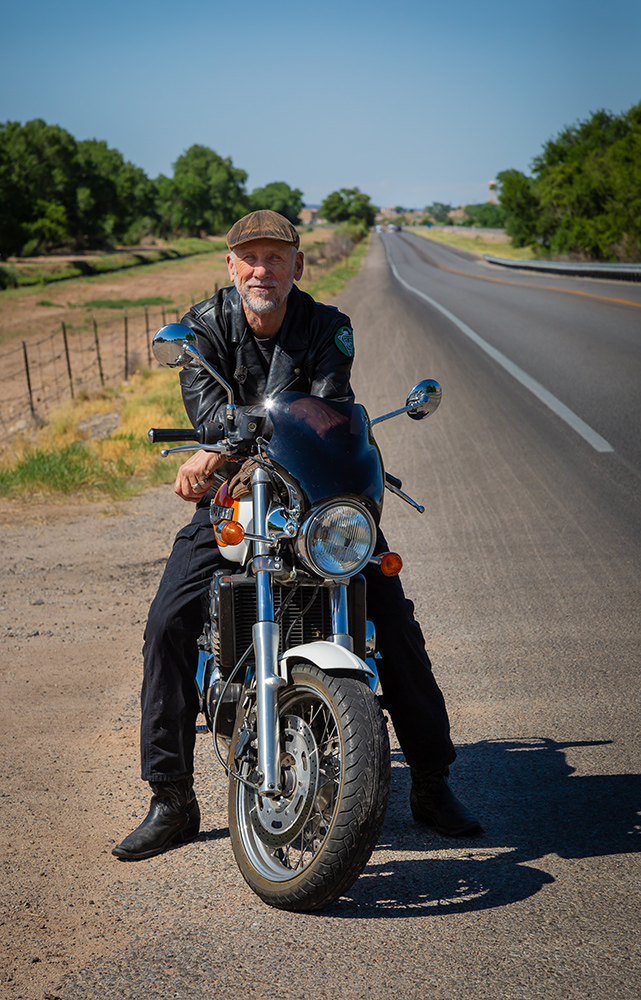B.C. Nowlin
B.C. Nowlin defines his art as “a border town…a journey”; and it certainly mirrors his cross cultural background. A native of Alameda, New Mexico, his family’s land formed the southern boundary of the Sandia Pueblo Reservation. Nowlin came of age steeped in experiences of vibrant Hispanic culture and Native Puebloan mysticism. His enrollment in seminary school and service to the United States Marine Corps define the paradox of his early life choices.
At age 12, Nowlin bicycled to purchase his first oil paints and canvas. Five years later, he was expelled from high school art class by an instructor enraged at his insistence on painting his images, his way. Nowlin’s die was cast and his development without any formal art education is a signature aspect of his imagery and personality.
“Nowlin’s diverse and prolific early images may have been the result of childhood pressure to please religious, relentlessly critical parents or simply escape from his blue-collar 20s as a construction worker and truck driver.Whatever his motives, Nowlin became something of a road warrior as an artist, crafting a lifestyle of constant travel, painting, exhibition and chaotic experimentation with his arts’ direction. Nowlin changes images faster than most of us change clothes. He avoids clichés as assiduously as he would stepping barefoot into cactus.”– Washington Post

Nowlin attracted praise and criticism in the early 1980s as an iconic maverick. His lonely, androgynous, bicycling portraits of Native Americana challenged the classical stereotype; along with Cannon, Red Star, Singer, Schoeder and Pletka, Nowlin was recognized as one of the avatars of the “New West.” Within a decade, their bold, controversial images swept American Southwestern Art from regional to international significance.
Nowlin’s native images are sourced from more than romantic sentiment. Since 1986, he has been involved in the politics and spirituality of the Lakota Sioux cultures and has worked on their behalf as a designated spokesman in off-reservation disputes.
The superficial accessibility of Nowlin’s best known work can easily lead to narrative assumptions, but even his most obvious imagery belies illustration. Close observation reveals his ‘Native Americans’ are cloaked in designs more akin to Gustav Klimt’s lovers, and his ‘Pueblos’ closely evoke architecture of the Middle East in scope and atmosphere. Nowlin is a paradox; uniquely experienced in Native American ‘placeness’ in his own personal history, he is directing us entirely elsewhere.
Jay Leno once joked that if you turned Nowlin’s paintings around, “you can see every face on the back,” as if the viewer is witnessing a point of departure as Nowlin’s mysterious figures embark on journeys toward an ever present, distant light.
Without using photos, sketches or reference material, Nowlin’s visual catalog of spiritual journeys has become signature imagery. His palette reflects a facility of style and a complex originality that has attracted exhibitions in galleries, corporate and museum collections worldwide.
“A mythical realist of the highest order … Nowlin’s work is breathtaking.” – Southwest Art
Nowlin’s works have become familiar Hollywood set pieces, album covers and popular posters. His paintings have been featured in newspaper and magazine articles as well as television documentaries.
He has exhibited in places as diverse as the Presidential Palace in Costa Rica and the Museum of Iraq in Baghdad. Nowlin’scollectors include Conoco, Hewlett-Packard, Burger King, Fingerhut, Johnson and Johnson, Sachs Motor Corp, Nobel Sisco and the Discovery Channel.
Recent works showcasing iconic nudes, floating vessels and 1950’s motels offer tantalizing hints of more radicalized imagery to come. In 2012, Nowlin revealed his “Out-Of-Control” images, an explosive roadside vision of fiery post-industrial chaos. He developed this imagery for a decade before releasing it to the public.
“Nowlin’s best work taps deep-seated, populist sentiments… a poignant recognition of the chaos and beauty of our contemporaries lives.” – H.K.
